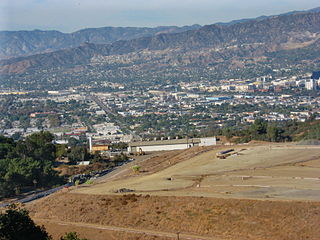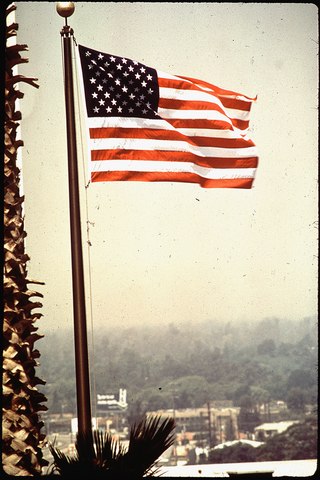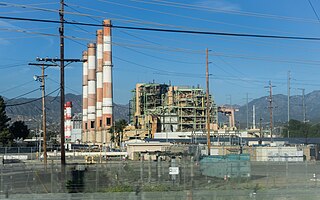Related Research Articles

Smog, or smoke fog, is a type of intense air pollution. The word "smog" was coined in the early 20th century, and is a portmanteau of the words smoke and fog to refer to smoky fog due to its opacity, and odor. The word was then intended to refer to what was sometimes known as pea soup fog, a familiar and serious problem in London from the 19th century to the mid-20th century, where it was commonly known as a London particular or London fog. This kind of visible air pollution is composed of nitrogen oxides, sulfur oxide, ozone, smoke and other particulates. Man-made smog is derived from coal combustion emissions, vehicular emissions, industrial emissions, forest and agricultural fires and photochemical reactions of these emissions.

Environmental engineering is a professional engineering discipline related to environmental science. It encompasses broad scientific topics like chemistry, biology, ecology, geology, hydraulics, hydrology, microbiology, and mathematics to create solutions that will protect and also improve the health of living organisms and improve the quality of the environment. Environmental engineering is a sub-discipline of civil engineering and chemical engineering. While on the part of civil engineering, the Environmental Engineering is focused mainly on Sanitary Engineering.
The California Air Resources Board is an agency of the government of California that aims to reduce air pollution. Established in 1967 when then-governor Ronald Reagan signed the Mulford-Carrell Act, combining the Bureau of Air Sanitation and the Motor Vehicle Pollution Control Board, CARB is a department within the cabinet-level California Environmental Protection Agency.
Vehicle emissions control is the study of reducing the emissions produced by motor vehicles, especially internal combustion engines.

Exhaust gas or flue gas is emitted as a result of the combustion of fuels such as natural gas, gasoline (petrol), diesel fuel, fuel oil, biodiesel blends, or coal. According to the type of engine, it is discharged into the atmosphere through an exhaust pipe, flue gas stack, or propelling nozzle. It often disperses downwind in a pattern called an exhaust plume.
Regional Clean Air Incentives Market (RECLAIM) is an emissions trading program operating in the state of California since 1994. Under the trading program, hundreds of polluting facilities are required to cut their emissions of nitrogen oxides (NOx) and sulfur oxides (SOx).
The Bay Area Air Quality Management District (BAAQMD) is a public agency that regulates the stationary sources of air pollution in the nine counties of California's San Francisco Bay Area: Alameda, Contra Costa, Marin, Napa, San Francisco, San Mateo, Santa Clara, southwestern Solano, and southern Sonoma. The BAAQMD is governed by a 24-member Board of Directors composed of elected officials from each of the nine Bay Area counties. The board has the duty of adopting air pollution regulations for the district. It is one of 35 Air Quality Management Districts in California.

The Toyon Canyon Landfill is a controversial landfill wholly within Griffith Park in the Los Feliz hillside neighborhood of greater Hollywood in central Los Angeles, California in the Santa Monica Mountains. Filling began in 1957 and ended in 1985. A lawsuit in 1959 attempted to stop the project but was unsuccessful. A summary of the lawsuit is available here. There was a move in the 1980s to expand the landfill into Royce's Canyon to the northwest, but that was defeated.
Arie Jan Haagen-Smit was a Dutch chemist. He is best known for linking the smog in Southern California to automobiles and is therefore known by many as the "father" of air pollution control. After serving as an original board member of the Motor Vehicle Pollution Control Board, formed in 1960 to combat the smog, Dr. Haagen-Smit became the California Air Resources Board's first chairman in 1968. Shortly before his death in Pasadena, California of lung cancer, the Air Resources Board's El Monte Laboratory was named after him.
Air pollution is the introduction of chemicals, particulate matter, or biological materials into the atmosphere, causing harm or discomfort to humans or other living organisms, or damaging ecosystems. Air pollution can cause health problems including, but not limited to, infections, behavioral changes, cancer, organ failure, and premature death. These health effects are not equally distributed across the U.S population; there are demographic disparities by race, ethnicity, socioeconomic status, and education. Air pollution can derive from natural sources, or anthropogenic sources. Anthropogenic air pollution has affected the United States since the beginning of the Industrial Revolution.

Pollution in California relates to the degree of pollution in the air, water, and land of the state of California. Pollution is defined as the addition of any substance or any form of energy to the environment at a faster rate than it can be dispersed, diluted, decomposed, recycled, or stored in some harmless form. The combination of three main factors are the cause of notable unhealthy levels of air pollution in California: the activities of over 39 million people, a mountainous terrain that traps pollution, and a warm climate that helps form ozone and other pollutants. Eight of the ten cities in the US with the highest year-round concentration of particulate matter between 2013 and 2015 were in California, and seven out of the ten cities in the US with the worst ozone pollution were also in California. Studies show that pollutants prevalent in California are linked to several health issues, including asthma, lung cancer, birth complications, and premature death. In 2016, Bakersfield, California recorded the highest level of airborne pollutants of any city in the United States.
The Carl Moyer Memorial Air Quality Standards Attainment Program is a State of California engine retrofit and replacement program implemented through the cooperative efforts of local air districts such as the Bay Area Air Quality Management District (BAAQMD) and the California Air Resources Board (ARB). The BAAQMD's Carl Moyer Program is managed by the Air District's Strategic Incentives Division (SID). The program provides grant funding to encourage the voluntary purchase of cleaner-than-required engines, equipment, and emission reduction technologies in an effort to rapidly reduce air pollution. While regulations continue to be the primary means to reduce air pollution emissions, the Carl Moyer Program plays a complementary role to California’s regulatory program by funding emission reductions that are surplus, that is, early and/or in excess of what is required by regulation.

Environment America is a federation of state-based environmental advocacy organizations in the United States. The organization researches and advocates for environmental policies through lobbying, litigation, and the mobilization of public support. Environment America advocates new laws and policies to address climate change, air pollution and water pollution, and is a proponent of clean energy, while opposing offshore drilling.

The California Smog Check Program requires vehicles that were manufactured in 1976 or later to participate in the biennial smog check program in participating counties. The program's stated aim is to reduce air pollution from vehicles by ensuring that cars with excessive emissions are repaired in accordance with federal and state guidelines. With some exceptions, gasoline-powered vehicles, hybrid vehicles, and alternative-fuel vehicles that are eight model-years old or newer are not required to participate; instead, these vehicles pay a smog abatement fee for the first 8 years in place of being required to pass a smog check. The eight-year exception does not apply to nonresident vehicles being registered in California for the first time, diesel vehicles 1998 model or newer and weighing 14,000 lbs or less, or specially constructed vehicles 1976 and newer. The program is a joint effort between the California Air Resources Board, the California Bureau of Automotive Repair, and the California Department of Motor Vehicles.
The South Coast Air Basin—SCAB is one of several regional air basin areas designated by the state of California, for the purpose of air quality management and air pollution control in Southern California. The SCAB district was created in 1969. and includes all of Orange County and the non-desert regions of Los Angeles County, Riverside County, and San Bernardino County. The region covers approximately 17100 km2 and includes much of the Greater Los Angeles Area, which is home to approximately 18 million people.
The California Statewide Truck and Bus Rule was initially adopted in December 2008 by the California Air Resources Board (CARB) and requires all heavy-duty diesel trucks and buses that operate in California to retrofit or replace engines in order to reduce diesel emissions. All privately and federally owned diesel-fueled trucks and buses, and privately and publicly owned school buses with a gross vehicle weight rating (GVWR) greater than 14,000 pounds, are covered by the regulation.
The Ventura County Air Pollution Control District (VCAPCD), formed in 1968, is the air pollution agency responsible mainly for regulating stationary sources of air pollution for Ventura County. The District was formed by the Board of Supervisors in response to the county's first air pollution study which identified Ventura County as having a severe air quality problem.
James N. Pitts Jr. was an American chemist and researcher known for his work in the fields of photochemistry and atmospheric chemistry. Pitts was a pioneer in the study of smog and air pollution, especially in Los Angeles County. Pitts co-founded the Statewide Air Pollution Research Center at the University of California, Riverside in 1961 and served as the center's director from 1970 to 1988. He authored more than 400 scientific publications and four books on the subjects, especially smog.

The Valley Generating Station is a natural gas-fired power station located in Sun Valley, Los Angeles, California.
References
- ↑ SCAQMD Air Quality Monitoring and Forecast Map Archived 2007-09-27 at the Wayback Machine
- ↑ Monitoring, AQI, Standards & Notification, The South Coast Perspective Joe Cassmassi, Senior Meteorologist, SCAQMD, April 2004
- ↑ Beychok, M.R. (2005). Fundamentals Of Stack Gas Dispersion (4th ed.). author-published. ISBN 0-9644588-0-2.
- ↑ Air Quality Modeling
- ↑ "Board Members". www.aqmd.gov. Retrieved 2019-01-15.
- ↑ Sforza, Teri (December 22, 2014). "Cities violated open-meeting laws, county charges". Orange County Register. Retrieved September 11, 2016.
- 1 2 Gerda, Nick (November 6, 2015). "Republicans Succeed in Kicking Santa Ana Mayor Off Air Quality Board". Voice of OC. Retrieved September 11, 2016.
- ↑ Barboza, Tony (June 7, 2019). "Southern California's most toxic polluters will pay more under air board's fee hike". Los Angeles Times . Retrieved 2019-06-08.